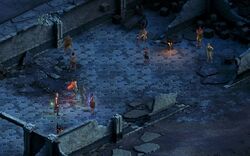RPG Codex Retrospective Interview: Al Escudero on Deathlord and Spelljammer: Pirates of Realmspace
RPG Codex Retrospective Interview: Al Escudero on Deathlord and Spelljammer: Pirates of Realmspace
Codex Interview - posted by Crooked Bee on Tue 6 November 2012, 17:03:45
Tags: Al Escudero; Deathlord; Electronic Arts; Retrospective Interview; Spelljammer: Pirates of Realmspace; Strategic Simulations, Inc.In this retrospective interview, we talk to Al Escudero, the designer behind two notable and unique if relatively obscure CRPGs, Electronic Arts' Deathlord (1987) and SSI's Spelljammer: Pirates of Realmspace (1992). The interview's main focus is Deathlord, but it also touches on Spelljammer's development and Al Escudero's career as a whole. As you can see from the interview, both Deathlord and Spelljammer had it really rough during development, to the point where the publisher would change the entire theme/concept of the game on the fly - something you would expect from Electronic Arts, I guess.
Have a snippet:
Read the full article: RPG Codex Retrospective Interview: Al Escudero on Deathlord and Spelljammer CRPG
Have a snippet:
What motivated you to choose the quasi-Japanese setting for Deathlord? Were the Japanese names for classes, weapons, spells, etc., there just for flavor, or did the whole thing grow out of your fascination with Japanese culture?
Honestly, no. Though I had a budding interest in Japanese culture at the time, the game was originally created with a Norse/Teutonic theme, and I had the game finished that way. It was the marketing dept at EA that insisted we change it (at the last minute) to an Oriental/Japanese theme. I was given 5 weeks to change all the art, story, spell names, equipment names, location names, etc. I was quite upset about it. I had a game I had crafted over a year and a half I needed to convert to an entirely different style at the 11th hour and wasn't given sufficient time to do the new style justice. It felt like a hack to me, and I hated doing it. If I'd had a few months, time to do reading on Japanese culture and myths, time to craft a tale that tapped into their rich Mythology, I feel I could have done a far better job, as it was I felt very dissatisfied.
What were your goals and intentions with Deathlord? What kind of game did you set out to make, and in what ways did you intend Deathlord to be different from other games of the era?
There were a number of goals, but primarily I wanted to make it BIG. I loved playing rpg's, but they seemed to be over so quickly, and the content often felt very thin. The RPGS of the time were ones like Bard's Tale and Wizardry that were a single dungeon, or Ultima 3, which had a small world with a lot of generic dungeons that were all more or less the same. I wanted to make Deathlord feel like a real world, with big oceans, climate zones, and different lands with different customs and styles. To accomplish this we created a huge streaming world with dozens of dungeons that had unique themes. In the course of creating the ones integral to the main story line, we also created numerous 'just for fun' dungeons that were explorations of various concepts - mazes, elements, illusions, etc. I ultimately added those into the game anyway as 'filler'. Akin to the Oblivion's and Skyrim's of later years so that there were new things to explore even if you had finished the game.
What were the challenges involved in Spelljammer's development, and were you pleased with the state that the game was released in? In hindsight, to what extent would you say you succeeded in your goals and how do you feel about the game today?
Similar to Deathlord, another mid-project change in direction happened. Initially Spelljammer was going to be an rpg. You would fly through space, and explore abandoned Dwarven citadels, floating castles and dungeons on alien worlds - but a few months into development, the game was cut back to a strategy game. I had to take my ambitious space-rpg and pare it down to something more like interceptor with magic. The game I got isn't really the one I set out to make.
You call Spelljammer's schedule "aggressive." Why did SSI rush Spelljammer's development? What were their reasons for that, as well as for the mid-project change in the game's concept?
I was never told explicitly why it was rushed. If I had to speculate, Dark Sun was over schedule and presumably over budget. It was probably the single most important title the company was producing at the time and had a huge development team and a lot riding on its success. I got the impression that anything that took resources away from Dark Sun was being reigned in.
Honestly, no. Though I had a budding interest in Japanese culture at the time, the game was originally created with a Norse/Teutonic theme, and I had the game finished that way. It was the marketing dept at EA that insisted we change it (at the last minute) to an Oriental/Japanese theme. I was given 5 weeks to change all the art, story, spell names, equipment names, location names, etc. I was quite upset about it. I had a game I had crafted over a year and a half I needed to convert to an entirely different style at the 11th hour and wasn't given sufficient time to do the new style justice. It felt like a hack to me, and I hated doing it. If I'd had a few months, time to do reading on Japanese culture and myths, time to craft a tale that tapped into their rich Mythology, I feel I could have done a far better job, as it was I felt very dissatisfied.
What were your goals and intentions with Deathlord? What kind of game did you set out to make, and in what ways did you intend Deathlord to be different from other games of the era?
There were a number of goals, but primarily I wanted to make it BIG. I loved playing rpg's, but they seemed to be over so quickly, and the content often felt very thin. The RPGS of the time were ones like Bard's Tale and Wizardry that were a single dungeon, or Ultima 3, which had a small world with a lot of generic dungeons that were all more or less the same. I wanted to make Deathlord feel like a real world, with big oceans, climate zones, and different lands with different customs and styles. To accomplish this we created a huge streaming world with dozens of dungeons that had unique themes. In the course of creating the ones integral to the main story line, we also created numerous 'just for fun' dungeons that were explorations of various concepts - mazes, elements, illusions, etc. I ultimately added those into the game anyway as 'filler'. Akin to the Oblivion's and Skyrim's of later years so that there were new things to explore even if you had finished the game.
What were the challenges involved in Spelljammer's development, and were you pleased with the state that the game was released in? In hindsight, to what extent would you say you succeeded in your goals and how do you feel about the game today?
Similar to Deathlord, another mid-project change in direction happened. Initially Spelljammer was going to be an rpg. You would fly through space, and explore abandoned Dwarven citadels, floating castles and dungeons on alien worlds - but a few months into development, the game was cut back to a strategy game. I had to take my ambitious space-rpg and pare it down to something more like interceptor with magic. The game I got isn't really the one I set out to make.
You call Spelljammer's schedule "aggressive." Why did SSI rush Spelljammer's development? What were their reasons for that, as well as for the mid-project change in the game's concept?
I was never told explicitly why it was rushed. If I had to speculate, Dark Sun was over schedule and presumably over budget. It was probably the single most important title the company was producing at the time and had a huge development team and a lot riding on its success. I got the impression that anything that took resources away from Dark Sun was being reigned in.
Read the full article: RPG Codex Retrospective Interview: Al Escudero on Deathlord and Spelljammer CRPG
RPG Codex Retrospective Interviews is a series that grew out of our fascination with the rich history of computer role-playing games. It focuses on developers and individual titles that made a unique or significant contribution to the genre, aiming to cover a developer's career and approach to RPG design or, respectively, the most relevant aspects of the game in question and the design philosophy behind it.
In this retrospective interview, we talk to Al Escudero, the designer behind two notable and unique CRPGs, Electronic Arts' Deathlord (1987) and SSI's Spelljammer: Pirates of Realmspace (1992). The interview's main focus is Deathlord, but it also touches on Spelljammer's development and Al Escudero's career as a whole. As you can see from the interview, both Deathlord and Spelljammer had it really rough during development, to the point where the publisher would change the entire theme/concept of the game on the fly - something you would expect from Electronic Arts, I guess.
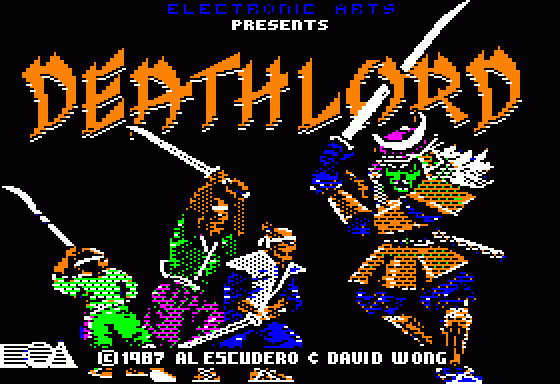
Deathlord's Apple II title screen
Interview: Al Escudero on Deathlord and Spelljammer
Can you tell us a bit about yourself and how you got involved in video game development? Did you come from pen and paper RPGs?
What were your goals and intentions with Deathlord? What kind of game did you set out to make, and in what ways did you intend Deathlord to be different from other games of the era?
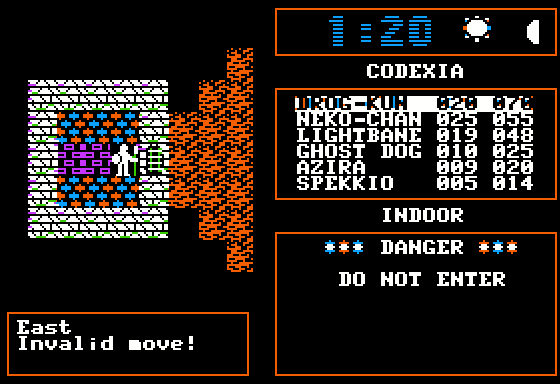
The city of demons is located inside a volcano, so prepare to get some lava burns.
Deathlord allows the player to import characters from Ultima III, Bard's Tale and Wizardry. Were those the games that inspired you the most? Would you agree if I described Deathlord as, among other things, an attempt to bring Wizardry's hardcore dungeon design over to Ultima's top down perspective? (After all, dungeon design was never the Ultima series' forte.) How did you come up with this idea?
What motivated you to choose the quasi-Japanese setting for Deathlord? Were the Japanese names for classes, weapons, spells, etc., there just for flavor, or did the whole thing grow out of your fascination with Japanese culture?
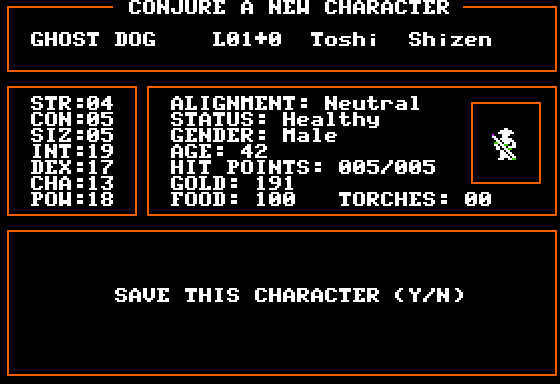
So, uhm... what's a Toshi?
There are 16 different character classes in Deathlord that you can choose from for your 6-character party. How did you approach designing these classes?
Deathlord features some of the best top-down dungeon design in the history of the genre. Most dungeons have a unique and memorable theme, and their design is as unforgiving as it is inventive and clever. Can you talk in some detail about how you went about creating them? How did you come up with all the various dungeons, and what were the principles behind Deathlord's dungeon and puzzle design? Do you have a favorite of all these dungeons?
With its 17 archipelagos and continents, each with unique content, Deathlord is one of the most sprawling non-procedurally generated CRPGs. Why did you decide to go for such a huge world instead of making a more compact game?
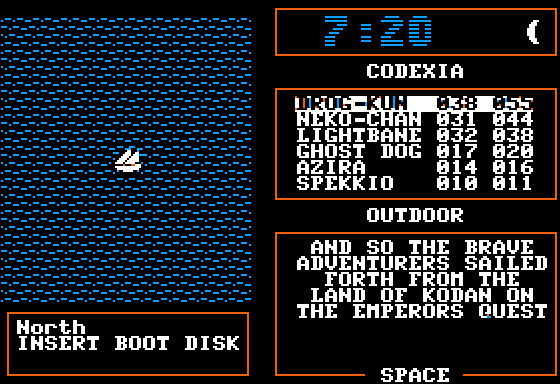
The game really opens up once you get a ship. Unfortunately, it doesn't protect you from numerous and deadly sea monsters.
NPCs in Deathlord do not have a lot of things to say, nor are there many things you can ask them about, with at most 2-3 keywords for every plot-relevant NPC. Did you originally plan to flesh out the NPCs more fully, or was the concept of the game's character interaction system supposed to be minimalistic and completely clue-driven right from the start?
Given the game's sheer size and difficulty, the enforced ironman (save on character death) mechanic must have made Deathlord one of the least finished games ever. Why did you decide to implement it? Was it your homage to Wizardry?
How long did it take you to develop Deathlord? What were the main challenges you faced during the development, and what moment do you remember most fondly from your time on the game?
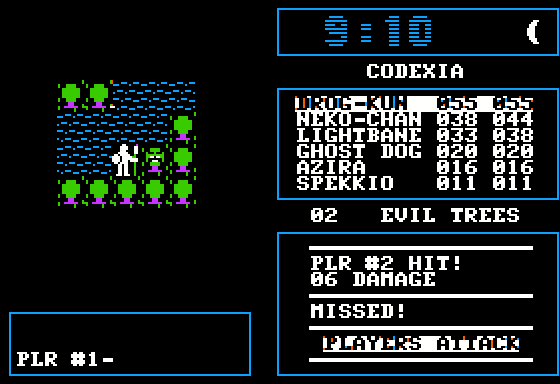
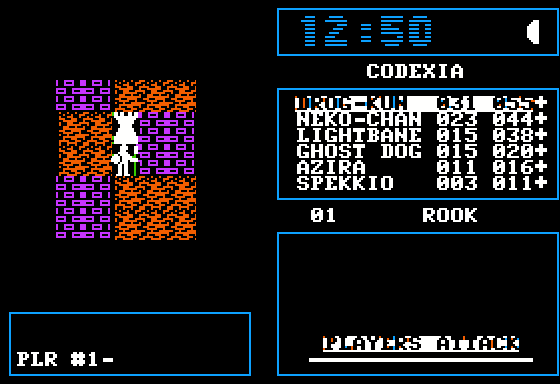
Evil trees and evil rooks are just some of the monsters inhabiting the bizarre world of Deathlord.
How did you end up working with Electronic Arts, and how large was their influence on Deathlord's design and development?
Were you perfectly satisfied with the way Deathlord turned out? Looking back at the game now, would you have changed anything about it?
How would you describe the reception the game received? Was it successful enough in your view? If it was not, what do you think were the reasons for that?
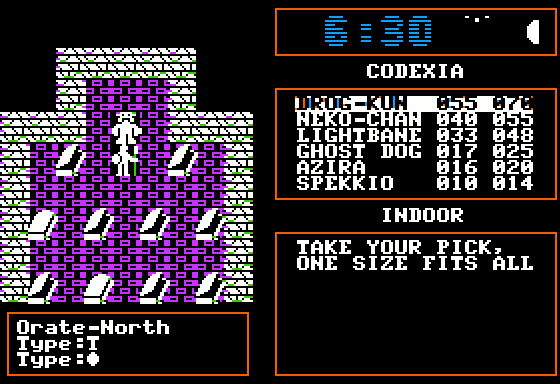
Why wasn't there a sequel to Deathlord? Did you have any plans for one?
Can you talk in more detail about Deathlord's original setting and plot and the elements of Norse culture and mythology it was supposed to include? You also say you had the story for the sequel planned out. What kind of plot did you have in mind for it?

Cold storage where Malkanth's demons store their food.
Another CRPG you were involved with, as director and designer, was Spelljammer: Pirates of Realmspace, published by SSI in 1992. How did it happen that you started working on a Spelljammer CRPG? At the time, how did you feel about switching to the Spelljammer setting?
Spelljammer is a pretty divisive and unorthodox CRPG, generating mixed reception to this day. What were you trying to achieve with it, design-wise? How faithful did you want the game to be to the pen and paper Spelljammer, and what were the guidelines you had in mind for translating the latter to the computer?
Spelljammer features two different combat systems; one for space battles and one for squad battles. How did you go about designing the two of them, and why did you decide to make space combat real-time instead of turn-based?
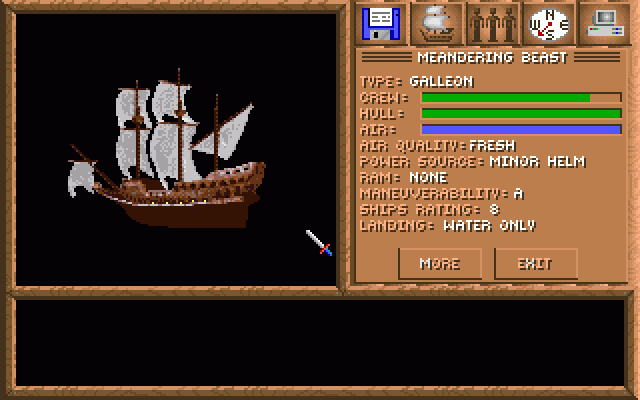
In Spelljammer your ship is one of your most important assets.
One feature that reviews criticized Pirates of Realmspace for was its limited plotline, the same kind of criticism that might be directed at Deathlord as well. What was your stance on the importance of plot for a CRPG? Did you feel this kind of criticism could be misguided?
What were the challenges involved in Spelljammer's development, and were you pleased with the state that the game was released in? In hindsight, to what extent would you say you succeeded in your goals and how do you feel about the game today?
You call Spelljammer's schedule "aggressive." Why did SSI rush Spelljammer's development? What were their reasons for that, as well as for the mid-project change in the game's concept?
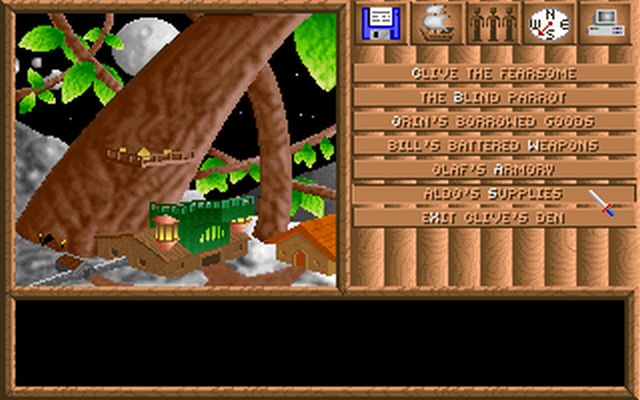
An alien... tree settlement?
Before designing the Spelljammer CRPG, you also worked on SSI's Renegade Legion: Interceptor. How did you get hired by SSI, and how would you describe the experience of working with them?
In retrospect, what are you most proud of about Deathlord and Spelljammer? What are the features that particularly stand out to you today?
Can you give us a rundown of what you have been involved with since the Spelljammer CRPG and what you are up to these days?
Thank you for your time.
For other entries in our retrospective interview series, click here.
I would like to thank MMXI for his feedback on the first draft of the questions.
In this retrospective interview, we talk to Al Escudero, the designer behind two notable and unique CRPGs, Electronic Arts' Deathlord (1987) and SSI's Spelljammer: Pirates of Realmspace (1992). The interview's main focus is Deathlord, but it also touches on Spelljammer's development and Al Escudero's career as a whole. As you can see from the interview, both Deathlord and Spelljammer had it really rough during development, to the point where the publisher would change the entire theme/concept of the game on the fly - something you would expect from Electronic Arts, I guess.
Retrospective: Deathlord
[Written by Crooked Bee]
Released in 1987 for the Apple II and Commodore 64, Deathlord is, unusually for a CRPG, a Japanese-themed game. It has a top down view similar to Ultima and turn- and phase-based combat in the vein of Wizardry, 6-character party included. There are 8 races and 16 classes in total, including 4 spellcaster classes. You don't get to pick any of the familiar classes or races at character creation; instead you get to make your character a Toshi or an Obake, a Mahotsukai or a Ronin. Many of these races and classes can, of course, be traced down to their rough D&D equivalents, and the game even gives you the option of importing your Bard's Tale, Wizardry or Ultima III party. However, Deathlord's character development system is unique enough to make importing a ready-to-play party much less appealing than experimenting with different party builds yourself. I'd recommend starting out with at least three spellcasters, since each spellcasting class has a compelling and large set of spells, and gaining acess to new spells and playing around with them is one of Deathlord's most exciting aspects. Levels come slow - a bit too slow at times, somewhat lagging behind the exploration - but each of them brings a significant increase in power and allows you to brave areas you previously wouldn't dare to.
And there are a lot of areas to brave. With its 17 archipelagos and continents, Deathlord's world is huge and dwarfs even that of Ultima V. Each continent has its own hand-designed content, a large part of which is optional, but in-between the continents the world can feel too empty sometimes. I would say that not so much the world itself as the overworld locations (towns, ruins, graveyards, etc.) and the dungeons are the real meat, and the real high point, of the game. Each has deadly traps and secrets to find. Each is designed in a unique and clever way - there is almost no "filler." Many locations show more than they explicitly tell, by way of their design, surroundings, and the NPCs inhabiting them. For one, the picture of the eternal yet unstable opposition between Fort Demonguard and Malkanth, the volcanic city of demons, belongs to the most evocative moments I've witnessed in a video game.
Like world exploration, dungeon exploration in Deathlord is top-down. Personally I like to think of it as a hardcore Wizardry-style dungeon romp "translated" into a top-down view. The ingenuity of Deathlord's design is to make this translation flow really well despite the obvious difficulties involved in bringing such elements as chutes, traps, teleports, environmental hazards and secret doors over from a first-person to a top-down perspective. Together with 128 unique monsters, the dungeons will make sure to test the abilities of your characters quite thoroughly. As someone who plays CRPGs not least for well-designed dungeons, I feel that Deathlord's dungeon design belongs to the best top-down dungeon design in the history of the genre. Most dungeons have a unique and memorable theme, and their design is as unforgiving as it is inventive and clever. You won't make it far without accurately mapping them out, and some secrets are only noticeable when you study the map. To an enthusiastic dungeon crawler, Deathlord is one of the ultimate games.
Apart from the character development and the location and dungeon design, another high point of Deathlord is how exploration is presented. There are no quest objectives, or quests at all. There is only the starting clue that Deathlord, the game's villain, gives you - seven words, six items, and a challenge to find them - and an overwhelmingly huge world into which you're thrown. No one ever leads you by the nose or holds your hand. There is barely even any idle NPC chatter. Each clue only begets further clues, and it is exclusively up to you and your power of observation to decypher them, put them together, and ultimately have them lead you to and through the final dungeon. The clues are not just obscure, but often difficult to find as well. There are many places, such as prisons, private houses or closed off institutions, that you can't just wander inside; you'll have to break into them, with the consequence of fighting the entire town guard that come springing at you. However, you might learn valuable clues if you do take the risk - all the greater originally, when playing the game on the Apple II or C64 and not on an emulator, given the permadeath.
Yes, permadeath. Everything above would be enough to make Deathlord a very challenging CRPG, but it is its save system, or rather a lack thereof, that makes it probably the least finished CRPG on the planet. Deathlord only has one savegame slot, which gets overwritten every time your party enters a new screen or a character dies. When killed, you'll need another party to rescue and resurrect your old one. This kind of system worked well in Wizardry, which focused on a single compact dungeon, but it feels frustratingly out of place in a huge open world game.
Given the game's setting, it comes across as a nice touch that all equipment and spells too have Japanese names, but it is also the game's second annoyance (out of three). Although the manual translates most of the basic equipment for you, you'll never know which weapon or armor is the best until you experiment with it - experiments that will cost you a lot of time, money, and likely character deaths. And did I mention that a character can only carry one type of each item at a time, so that picking up a new piece of equipment replaces the one you already have (which is now gone for good)? That said, Deathlord is pretty transparent as far as old CRPGs go; you won't get to know the exact statistics of a weapon, but the manual does contain compatibility tables for most of the equipment and even explains each and every spell in considerable detail. The unfamiliar character of the Japanese names is only really an obstacle in the beginning, but once you've acquainted yourself with the system, you'll start making equipment and spell decisions rather quickly and efficiently. The third and final annoyance is the cumbersome interface and inventory - to be fair, not an uncommon sight in old CRPGs. There is one excellent innovation to Deathlord's interface, though: the game lets you set up macros for the strings of keys that you feel like using the most frequently. This is the kind of interface solution that takes some time to get used to, but proves to be a godsend in the long run.
I only played Deathlord for the first time very recently - about a year ago, I think - but it didn't take me long to appreciate it enough to fall in love with it. For the first time player, there are three things that make Deathlord immediately stand out: its quasi-Japanese setting, its "ironman" difficulty, and its top notch location and dungeon design. It is therefore interesting to hear, in the interview that follows, that the Oriental setting wasn't supposed to be there at all - the game was originally designed with a Norse setting in mind - and that Al Escudero would tone done the difficulty if he were to revisit the game now. The dungeon design, however, is one point that both survived EA's butchering of the setting and has aged well, even if the world tree dungeon unfortunately didn't make it in.
Deathlord went relatively unnoticed and remains obscure, but if I had to rate all the obscure CRPGs that I've played, and I've played a lot, Deathlord would definitely be somewhere at the top.
[Written by Crooked Bee]
Released in 1987 for the Apple II and Commodore 64, Deathlord is, unusually for a CRPG, a Japanese-themed game. It has a top down view similar to Ultima and turn- and phase-based combat in the vein of Wizardry, 6-character party included. There are 8 races and 16 classes in total, including 4 spellcaster classes. You don't get to pick any of the familiar classes or races at character creation; instead you get to make your character a Toshi or an Obake, a Mahotsukai or a Ronin. Many of these races and classes can, of course, be traced down to their rough D&D equivalents, and the game even gives you the option of importing your Bard's Tale, Wizardry or Ultima III party. However, Deathlord's character development system is unique enough to make importing a ready-to-play party much less appealing than experimenting with different party builds yourself. I'd recommend starting out with at least three spellcasters, since each spellcasting class has a compelling and large set of spells, and gaining acess to new spells and playing around with them is one of Deathlord's most exciting aspects. Levels come slow - a bit too slow at times, somewhat lagging behind the exploration - but each of them brings a significant increase in power and allows you to brave areas you previously wouldn't dare to.
And there are a lot of areas to brave. With its 17 archipelagos and continents, Deathlord's world is huge and dwarfs even that of Ultima V. Each continent has its own hand-designed content, a large part of which is optional, but in-between the continents the world can feel too empty sometimes. I would say that not so much the world itself as the overworld locations (towns, ruins, graveyards, etc.) and the dungeons are the real meat, and the real high point, of the game. Each has deadly traps and secrets to find. Each is designed in a unique and clever way - there is almost no "filler." Many locations show more than they explicitly tell, by way of their design, surroundings, and the NPCs inhabiting them. For one, the picture of the eternal yet unstable opposition between Fort Demonguard and Malkanth, the volcanic city of demons, belongs to the most evocative moments I've witnessed in a video game.
Like world exploration, dungeon exploration in Deathlord is top-down. Personally I like to think of it as a hardcore Wizardry-style dungeon romp "translated" into a top-down view. The ingenuity of Deathlord's design is to make this translation flow really well despite the obvious difficulties involved in bringing such elements as chutes, traps, teleports, environmental hazards and secret doors over from a first-person to a top-down perspective. Together with 128 unique monsters, the dungeons will make sure to test the abilities of your characters quite thoroughly. As someone who plays CRPGs not least for well-designed dungeons, I feel that Deathlord's dungeon design belongs to the best top-down dungeon design in the history of the genre. Most dungeons have a unique and memorable theme, and their design is as unforgiving as it is inventive and clever. You won't make it far without accurately mapping them out, and some secrets are only noticeable when you study the map. To an enthusiastic dungeon crawler, Deathlord is one of the ultimate games.
Apart from the character development and the location and dungeon design, another high point of Deathlord is how exploration is presented. There are no quest objectives, or quests at all. There is only the starting clue that Deathlord, the game's villain, gives you - seven words, six items, and a challenge to find them - and an overwhelmingly huge world into which you're thrown. No one ever leads you by the nose or holds your hand. There is barely even any idle NPC chatter. Each clue only begets further clues, and it is exclusively up to you and your power of observation to decypher them, put them together, and ultimately have them lead you to and through the final dungeon. The clues are not just obscure, but often difficult to find as well. There are many places, such as prisons, private houses or closed off institutions, that you can't just wander inside; you'll have to break into them, with the consequence of fighting the entire town guard that come springing at you. However, you might learn valuable clues if you do take the risk - all the greater originally, when playing the game on the Apple II or C64 and not on an emulator, given the permadeath.
Yes, permadeath. Everything above would be enough to make Deathlord a very challenging CRPG, but it is its save system, or rather a lack thereof, that makes it probably the least finished CRPG on the planet. Deathlord only has one savegame slot, which gets overwritten every time your party enters a new screen or a character dies. When killed, you'll need another party to rescue and resurrect your old one. This kind of system worked well in Wizardry, which focused on a single compact dungeon, but it feels frustratingly out of place in a huge open world game.
Given the game's setting, it comes across as a nice touch that all equipment and spells too have Japanese names, but it is also the game's second annoyance (out of three). Although the manual translates most of the basic equipment for you, you'll never know which weapon or armor is the best until you experiment with it - experiments that will cost you a lot of time, money, and likely character deaths. And did I mention that a character can only carry one type of each item at a time, so that picking up a new piece of equipment replaces the one you already have (which is now gone for good)? That said, Deathlord is pretty transparent as far as old CRPGs go; you won't get to know the exact statistics of a weapon, but the manual does contain compatibility tables for most of the equipment and even explains each and every spell in considerable detail. The unfamiliar character of the Japanese names is only really an obstacle in the beginning, but once you've acquainted yourself with the system, you'll start making equipment and spell decisions rather quickly and efficiently. The third and final annoyance is the cumbersome interface and inventory - to be fair, not an uncommon sight in old CRPGs. There is one excellent innovation to Deathlord's interface, though: the game lets you set up macros for the strings of keys that you feel like using the most frequently. This is the kind of interface solution that takes some time to get used to, but proves to be a godsend in the long run.
I only played Deathlord for the first time very recently - about a year ago, I think - but it didn't take me long to appreciate it enough to fall in love with it. For the first time player, there are three things that make Deathlord immediately stand out: its quasi-Japanese setting, its "ironman" difficulty, and its top notch location and dungeon design. It is therefore interesting to hear, in the interview that follows, that the Oriental setting wasn't supposed to be there at all - the game was originally designed with a Norse setting in mind - and that Al Escudero would tone done the difficulty if he were to revisit the game now. The dungeon design, however, is one point that both survived EA's butchering of the setting and has aged well, even if the world tree dungeon unfortunately didn't make it in.
Deathlord went relatively unnoticed and remains obscure, but if I had to rate all the obscure CRPGs that I've played, and I've played a lot, Deathlord would definitely be somewhere at the top.

Deathlord's Apple II title screen
Interview: Al Escudero on Deathlord and Spelljammer
Can you tell us a bit about yourself and how you got involved in video game development? Did you come from pen and paper RPGs?
I'm not certain when my interest in game design started, but I recall re-writing the rules to Monopoly at age ten. Even at that age, if there was something I didn't like about a game, I was analyzing why and thinking of how to make it better. This carried into pen and paper rpg's, and eventually led me to video games. I recall being critical of some video games in a discussion with friends, and one of them challenged me "if you think you can do it better, then why don't you". So I set out to do so.
What were your goals and intentions with Deathlord? What kind of game did you set out to make, and in what ways did you intend Deathlord to be different from other games of the era?
There were a number of goals, but primarily I wanted to make it BIG. I loved playing rpg's, but they seemed to be over so quickly, and the content often felt very thin. The RPGS of the time were ones like Bard's Tale and Wizardry that were a single dungeon, or Ultima 3, which had a small world with a lot of generic dungeons that were all more or less the same. I wanted to make Deathlord feel like a real world, with big oceans, climate zones, and different lands with different customs and styles. To accomplish this we created a huge streaming world with dozens of dungeons that had unique themes. In the course of creating the ones integral to the main story line, we also created numerous 'just for fun' dungeons that were explorations of various concepts - mazes, elements, illusions, etc. I ultimately added those into the game anyway as 'filler'. Akin to the Oblivion's and Skyrim's of later years so that there were new things to explore even if you had finished the game.

The city of demons is located inside a volcano, so prepare to get some lava burns.
Deathlord allows the player to import characters from Ultima III, Bard's Tale and Wizardry. Were those the games that inspired you the most? Would you agree if I described Deathlord as, among other things, an attempt to bring Wizardry's hardcore dungeon design over to Ultima's top down perspective? (After all, dungeon design was never the Ultima series' forte.) How did you come up with this idea?
I observed that players tended to form attachments to characters in their RPGs and often used the same names in multiple games. The importation was a way to bring their favorite characters from another game into this one. Various aspects of those games also served as inspiration. There were aspects I liked that I tried to emulate, and aspects I didn't like which I tried to improve upon. For me it was the things I didn't like that really motivated me. If some aspect of a game annoyed me, it was in my nature to say "Ok, how do I fix this."
My shift to top-down dungeons was designed to create dungeons that had some personality. Lakes of fire, pillared halls, and rough walled caverns with dirt floors. 3D felt gimmicky to me, and I didn't think that the computers of the time were able to make 3D dungeons that didn't look like a rat's maze with a bunch of walls made out of 10x10 painted panels.
My shift to top-down dungeons was designed to create dungeons that had some personality. Lakes of fire, pillared halls, and rough walled caverns with dirt floors. 3D felt gimmicky to me, and I didn't think that the computers of the time were able to make 3D dungeons that didn't look like a rat's maze with a bunch of walls made out of 10x10 painted panels.
What motivated you to choose the quasi-Japanese setting for Deathlord? Were the Japanese names for classes, weapons, spells, etc., there just for flavor, or did the whole thing grow out of your fascination with Japanese culture?
Honestly, no. Though I had a budding interest in Japanese culture at the time, the game was originally created with a Norse/Teutonic theme, and I had the game finished that way. It was the marketing dept at EA that insisted we change it (at the last minute) to an Oriental/Japanese theme. I was given 5 weeks to change all the art, story, spell names, equipment names, location names, etc. I was quite upset about it. I had a game I had crafted over a year and a half I needed to convert to an entirely different style at the 11th hour and wasn't given sufficient time to do the new style justice. It felt like a hack to me, and I hated doing it. If I'd had a few months, time to do reading on Japanese culture and myths, time to craft a tale that tapped into their rich Mythology, I feel I could have done a far better job, as it was I felt very dissatisfied.

So, uhm... what's a Toshi?
There are 16 different character classes in Deathlord that you can choose from for your 6-character party. How did you approach designing these classes?
We tried to create characters that represented a variety of play styles. A mix of pure classes and hybrids that would allow most players to find the type of player they liked, or that they felt an affinity for.
Deathlord features some of the best top-down dungeon design in the history of the genre. Most dungeons have a unique and memorable theme, and their design is as unforgiving as it is inventive and clever. Can you talk in some detail about how you went about creating them? How did you come up with all the various dungeons, and what were the principles behind Deathlord's dungeon and puzzle design? Do you have a favorite of all these dungeons?
In this respect we benefitted from the decision not to go 3D. The flexibility afforded by the top down perspective gave us much greater creative freedom. We would design the dungeons by brainstorming fun 'themes' and build around that theme. The design was a collective effort on the part of my role-playing group at the time. We'd all brainstorm, a couple of us would build prototypes, and we'd all play them and provide feedback. Over the course of this experimentation, we created many more dungeons than we needed for the story line. The best became part of the core story, the rest became the 'for fun' filler dungeons.
I'm not sure I had a favorite dungeon as a whole, rather there were areas of various dungeons that I really liked because they had some particularly fun or clever twist to them.
I'm not sure I had a favorite dungeon as a whole, rather there were areas of various dungeons that I really liked because they had some particularly fun or clever twist to them.
With its 17 archipelagos and continents, each with unique content, Deathlord is one of the most sprawling non-procedurally generated CRPGs. Why did you decide to go for such a huge world instead of making a more compact game?
As I mentioned earlier, I was going for big. I wanted to feel like you were exploring a world. It wasn't trying to do the minimum and kick it out the door, it was a labor of love and I wanted to give people something that would entertain them for weeks, not days. If someone followed the A to B path they could finish the game in a couple of days, but I gave them lots of side paths that people could take. If someone wanted to build up their characters, I felt it would be more fun to give them something new to do instead of forcing them to farm the same stuff repeatedly.

The game really opens up once you get a ship. Unfortunately, it doesn't protect you from numerous and deadly sea monsters.
NPCs in Deathlord do not have a lot of things to say, nor are there many things you can ask them about, with at most 2-3 keywords for every plot-relevant NPC. Did you originally plan to flesh out the NPCs more fully, or was the concept of the game's character interaction system supposed to be minimalistic and completely clue-driven right from the start?
I went back and forth on this and finally settled on minimalistic. My experiments with dialog trees and my observations of my friends playing the various prototypes revealed that what they enjoyed the most was the combat, the puzzles, and the character building. Sifting through a lot of dialog to find the nuggets they needed seemed to them like a tedious chore that got in the way of the fun stuff.
In pen and paper games, the GM could use clever word plays, funny voices, and change the narrative on the fly to keep dialog entertaining. In a computer game, a lot of those tools go away and you're left with a 'find the clue in a stream of text' game, which isn't nearly as fun. I decided at the time to explore this further in the next game.
In pen and paper games, the GM could use clever word plays, funny voices, and change the narrative on the fly to keep dialog entertaining. In a computer game, a lot of those tools go away and you're left with a 'find the clue in a stream of text' game, which isn't nearly as fun. I decided at the time to explore this further in the next game.
Given the game's sheer size and difficulty, the enforced ironman (save on character death) mechanic must have made Deathlord one of the least finished games ever. Why did you decide to implement it? Was it your homage to Wizardry?
No. It was my first game and with the hindsight of 20 years of game development, I wouldn't have built the game that way today. If I knew then what I know now, I would have made the game not save on death so people could just restart from their last save. I really wanted people to explore and experiment, but saving on death is somewhat of a deterrent to exploration, so it was counter-productive. I can't recall my reasoning for making it that way, or why I didn't change it before it shipped, but it's at the top of the list of things I wish I'd done differently.
How long did it take you to develop Deathlord? What were the main challenges you faced during the development, and what moment do you remember most fondly from your time on the game?
All told almost two years from when we first started to tinker with the code to the day it shipped. The biggest challenge was changing the whole theme in 5 weeks. Most fond moment was watching one of my friends play a particularly difficult dungeon while a group of us watched in rapt silence for almost an hour, only occasionally whispering amongst ourselves and he finally made it though and everyone jumped up cheering and he got up and did a happy dance in front of us all.


Evil trees and evil rooks are just some of the monsters inhabiting the bizarre world of Deathlord.
How did you end up working with Electronic Arts, and how large was their influence on Deathlord's design and development?
I approached a number of publishers with the game, and several of them made offers. I decided on EA at the time because I felt they would do the most for my career. They made some great suggestions, but their decision to change the entire theme of the game at the last minute was a very drastic change which I feel did more harm than good.
With 20/20 hindsight I would have taken SSI up on their offer. I ended up working with them on future titles and enjoyed my working relationship with them.
With 20/20 hindsight I would have taken SSI up on their offer. I ended up working with them on future titles and enjoyed my working relationship with them.
Were you perfectly satisfied with the way Deathlord turned out? Looking back at the game now, would you have changed anything about it?
No. I think few designers are ever perfectly satisfied with a product they ship. There's always something you didn't have the time or budget for that you wish had made it in. In my case, the level of difficulty is the biggest thing I would have changed. I would have made the game more forgiving, and made the core path easier. Leaving challenging stuff is ok, but I would have made them side quests.
How would you describe the reception the game received? Was it successful enough in your view? If it was not, what do you think were the reasons for that?
It received a mixed reception, but I think it would have done better without the last minute theme change and if it had been a little less hard core. A number of factors contributed to the difficulty, not the least of which was my inexperience with QA practices at the time. I had the same people playing the game and I kept tuning and tweaking it as issues came up, but as my QA team got more experienced with the game I inadvertently made it harder. Tuning a game to be lightly challenging for hardcore gamers who were highly experienced with it resulted in a game that was blisteringly hard for casual gamers who didn't have the benefit of playing various incarnations of the game for a year.

Why wasn't there a sequel to Deathlord? Did you have any plans for one?
Yes, in fact I had the story planned out before Deathlord was even finished. I feel that the sequel would have been a far better game because I had the benefit of wisdom gained from the first time around. I would have done a number of things differently which I feel would have made the game much more successful.
Can you talk in more detail about Deathlord's original setting and plot and the elements of Norse culture and mythology it was supposed to include? You also say you had the story for the sequel planned out. What kind of plot did you have in mind for it?
The list of things that changed is quite long, but some of the more major changes are that the world was disk shaped and flat like a pizza and if you sailed too far you could sail off the edge of the world. We had a dungeon shaped like the world tree and you could travel down the trunk or along the branches to reach various portals that took you to other places. A lot more giants, trolls and draugr. We also had runes you could find, or win that would open paths on the world tree to new areas.
The sequel took place a few decades in the future. Fierce storms were ravaging the land, many supernatural manifestations such as possessions were becoming commonplace and the dead were rising from their graves. It was determined that by defeating the Deathlord, the heroes of old had disturbed the natural order. As it turns out, without a focus for evil, someone to keep the legions of hell in line and to draw them there like a beacon, evil spirits were running amok and demons that were previously confined to the hells were breaking loose. Rifts were also opening intermittently between the world and the hells, creating a smorgasbord of environmental disasters. Essentially things were going to hell and it was only getting worse.
Enter the new heroes. The emperor of old had taken the black orb which was the heart of the Deathlord and hid it in a place where he deemed it to be safe for all time, and placed many wards and protections over its resting place. The new heroes must decipher the clues, find the various keys, and journey into many dangerous places (which would have been hard enough without being embroiled in the chaos of an evil apocalypse) to recover the black heart and resurrect the Deathlord and thereby restore the natural order.
The sequel took place a few decades in the future. Fierce storms were ravaging the land, many supernatural manifestations such as possessions were becoming commonplace and the dead were rising from their graves. It was determined that by defeating the Deathlord, the heroes of old had disturbed the natural order. As it turns out, without a focus for evil, someone to keep the legions of hell in line and to draw them there like a beacon, evil spirits were running amok and demons that were previously confined to the hells were breaking loose. Rifts were also opening intermittently between the world and the hells, creating a smorgasbord of environmental disasters. Essentially things were going to hell and it was only getting worse.
Enter the new heroes. The emperor of old had taken the black orb which was the heart of the Deathlord and hid it in a place where he deemed it to be safe for all time, and placed many wards and protections over its resting place. The new heroes must decipher the clues, find the various keys, and journey into many dangerous places (which would have been hard enough without being embroiled in the chaos of an evil apocalypse) to recover the black heart and resurrect the Deathlord and thereby restore the natural order.

Cold storage where Malkanth's demons store their food.
Another CRPG you were involved with, as director and designer, was Spelljammer: Pirates of Realmspace, published by SSI in 1992. How did it happen that you started working on a Spelljammer CRPG? At the time, how did you feel about switching to the Spelljammer setting?
I was working on some other titles for SSI and they asked if I was interested in doing something with Spelljammer, and after some research I felt it had a lot of potential. It was an RPG where you weren't limited to a single fantasy setting. If you wanted to change the rules for your setting, you could just go somewhere else. Theoretically you could to that before by plane travelling, but Spelljammer made the journey itself more of an adventure.
Spelljammer is a pretty divisive and unorthodox CRPG, generating mixed reception to this day. What were you trying to achieve with it, design-wise? How faithful did you want the game to be to the pen and paper Spelljammer, and what were the guidelines you had in mind for translating the latter to the computer?
I was thinking less about staying true to pen and paper mechanics and more about how to make the product a fun experience on the computer while staying true to the core setting.
Spelljammer features two different combat systems; one for space battles and one for squad battles. How did you go about designing the two of them, and why did you decide to make space combat real-time instead of turn-based?
Space combat was made real time to try and create more of the excitement to having a space battle. I felt that the real-time combat would be more fun than a computer-based version of moving chits around on a hex map. The crew battles posed some interesting challenges in creating a way for large crews to fight while still feeling like you were had heroic characters involved in the battle.

In Spelljammer your ship is one of your most important assets.
One feature that reviews criticized Pirates of Realmspace for was its limited plotline, the same kind of criticism that might be directed at Deathlord as well. What was your stance on the importance of plot for a CRPG? Did you feel this kind of criticism could be misguided?
I like story and wish it had played a bigger role in both games, but I ran afoul of development considerations in both cases. In Deathlord, some elements of my plot got lost in translation to Japanese, or were trimmed in the 5 week rush to change themes. In Spelljammer, a combination of aggressive schedule and mid-project shift in genre from rpg to action/strategy torpedoed my original plotline.
What were the challenges involved in Spelljammer's development, and were you pleased with the state that the game was released in? In hindsight, to what extent would you say you succeeded in your goals and how do you feel about the game today?
Similar to Deathlord, another mid-project change in direction happened. Initially Spelljammer was going to be an rpg. You would fly through space, and explore abandoned Dwarven citadels, floating castles and dungeons on alien worlds - but a few months into development, the game was cut back to a strategy game. I had to take my ambitious space-rpg and pare it down to something more like interceptor with magic. The game I got isn't really the one I set out to make.
You call Spelljammer's schedule "aggressive." Why did SSI rush Spelljammer's development? What were their reasons for that, as well as for the mid-project change in the game's concept?
I was never told explicitly why it was rushed. If I had to speculate, Dark Sun was over schedule and presumably over budget. It was probably the single most important title the company was producing at the time and had a huge development team and a lot riding on its success. I got the impression that anything that took resources away from Dark Sun was being reigned in.

An alien... tree settlement?
Before designing the Spelljammer CRPG, you also worked on SSI's Renegade Legion: Interceptor. How did you get hired by SSI, and how would you describe the experience of working with them?
My experiences working with EA were somewhat mixed, and I approached SSI about doing some work for them. They were a fun bunch and most of them were hardcore gamers themselves, so talking to them about game concepts was always entertaining.
In retrospect, what are you most proud of about Deathlord and Spelljammer? What are the features that particularly stand out to you today?
I'm proud that despite many challenges and changes, I managed to get them finished and shipped. There were a number of occasions on both projects that it looked like they wouldn't see the light of day. There are so many games that make it partway through development, hit snags and never see the light of day. Even if the end results weren't what I had hoped they'd be, I'm glad I was able to find a way to make things work and ship the game.
Can you give us a rundown of what you have been involved with since the Spelljammer CRPG and what you are up to these days?
After Spelljammer I formed a company to work on online games. I had been trying to get head-to-head modem play into Interceptor and Spelljammer, but didn't have the budget or executive interest. I was also pitching MMOGs to EA since 1987, and a producer there gave my favorite quote ever "Online games are just a fad, there's no future in it". So I spent the next 8 years working on online games and in a moment of ultimate irony, my company was acquired by EA so they could get us to work on online games.
I worked on a number of console titles since then, and currently do consulting for companies both in and outside of the games industry.
I worked on a number of console titles since then, and currently do consulting for companies both in and outside of the games industry.
Thank you for your time.
For other entries in our retrospective interview series, click here.
I would like to thank MMXI for his feedback on the first draft of the questions.











